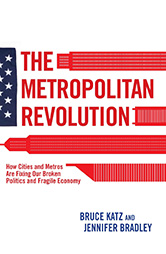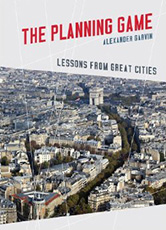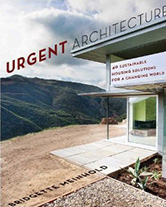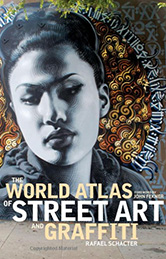Planetizen is pleased to release its twelfth annual list of the ten best books in urban planning, design and development published in 2013.

They’re happy, they’re smart, they’re in revolt! The resurgence of cities and the growing interest in everything urban is reflected in a list of honorees that is largely focused on the city.
As the world urbanizes at an astonishing rate, the authors recognized in this year’s list endeavor to make sense of the push and pull of culture, technology, psychology, politics, and visionary leaders on the development of cities past, present, and future. These explications of the urban condition range from the practical to the historical to the theoretical, all offering lessons on how to create livable, vibrant, and sustainable environments for the billions of new city dwellers expected by 2050.
The Planetizen editorial staff based this year's list on a number of criteria, including editorial reviews, popularity, number of references, sales figures, recommendations from experts and the book's potential impact on the urban planning, development and design professions.
We present our list in alphabetical order, and are not assigning rank. And now, on to the list!
 The End of Suburbs: Where the American Dream Is Moving
The End of Suburbs: Where the American Dream Is Moving
Leigh Gallagher
Portfolio, 272 pages
Of all the heartening news that comes from The End of the Suburbs, the most heartening of all may be the background of its author. Unlike the many tireless champions of smart growth whom she mentions, Leigh Gallagher is not herself an urban activist. She is a business reporter -- a veteran of Fortune Magazine -- and her premise is not merely that the suburbs are ugly or soulless or inefficient but rather that they no longer make business sense.
Gallagher opens at a particularly morose gathering of homebuilders, circa 2012, and proceeds to explain the many reasons why the days of galloping tract development are going the way of leaded gasoline. Communities can't bear the costs of infrastructure; Gallagher reports, and does not dispute, the claim that suburban sprawl is a "giant Ponzi scheme." Suburban kids don't want to grow up to be suburban adults. Middle-class comfort has, in some cases, given way to meth labs and foreclosures. And everyone is sick of driving.
Gallagher emphasizes how dramatic the shift has been, with descriptions of the booming days of 2003 reading like distant history. Of course, the suburbs aren't emptying out entirely (in part because center cities haven't added nearly enough units), but they're slowing down, and everyone is, according to Gallagher, waking up from their American dream.
 Happy City: Transforming Our Lives Through Urban Design
Happy City: Transforming Our Lives Through Urban Design
Charles Montgomery
Farrar, Straus and Giroux, 368 pages
Charles Montgomery ponders, “is urban design really powerful enough to make or break happiness?” In an engaging new book, he explores the philosophy and the psychology of happiness as it relates to urban denizens. In proposing a ‘basic recipe of urban happiness’, Happy Cities contrasts progressive, sustainable, ‘new urbanist’ and ‘peer-to-peer’ values with the commercialized, auto-centric and top-down planning of the last century.
Montgomery posits that until the last two decades, science lacked the ability to describe a relationship between design, psychology and social livability. Newer neurological testing instruments such as EEG and FMRI and a broadening of the definition of “happiness” beyond economic utility allows researchers to understand more subjective forms of happiness relating to experience, relationships and place. The book offers a tome of research providing planners and designers with the scientific vocabulary to discuss street engineering and community building in terms of mental and physical health.
Among many engaging examples, Happy Cities cites the rise of chronic cortisol release, associated with stress and heart disease, in commuters with uncertain transit routes or depressingly long commute times. Montgomery delves into the ‘oxytocin’ molecule, and recent evidence that peer-to-peer networks may also increase ego-reinforcing neurological connections to promote trust. The book also explores how bike culture reflects the viewpoint of ‘beta- endorphin pumped, risk taking’ cyclists rather than the needs of the ‘peripheral-vision challenged’ kids and seniors that are trying to share the road. Happy Cities ultimately advocates a ‘Redesign for Freedom’ and asserts this as a right of every citizen via Henri Lefebvre.
 A History of Future Cities
A History of Future Cities
Daniel Brook
W. W. Norton & Company, 480 pages
Daniel Brook's achievement does not exactly rival that of building the world's tallest skyscraper or pulling a new Paris out of frozen mud, but he makes a good showing nonetheless. History of Future Cities is either a history book with an incredible urban sensibility or an urban book with an impressive grasp of history. Either way, it does for the cities of St. Petersburg, Mumbai, Shanghai, and Dubai something that few urban histories ever do: it makes them interesting.
Those four cities would seem to have little in common, other than their appearance on Emirates Airlines' route map. And yet, Brook argues that each was planned, designed, developed, and promoted for the same reason: to eschew a provincial past and seize a cosmopolitan future. In each case, "cosmopolitan" means "the West." Built by ruling czars, imperialists, traders, and sheiks, respectively, each emulates the cities of the west and seeks to make western capital feel comfortable, as if each is a gigantic hotel (in Dubai's case, that's not so far off).
What's refreshing about Brook's analysis is that he ties each city to broader political analysis. He offers praise for Catherine the Great, and deep suspicion of the Chinese Communist Party, with wide-ranging commentary that is usually lost when scholars focus purely on local affairs.
 How to Study Public Life
How to Study Public Life
Jan Gehl and Birgitte Svarre
Island Press, 200 pages
With all the attention paid by planners and urban designers today to implementing the current theories on what makes places vibrant and popular, it is surprising how little time is invested in actually going out and watching how people use such spaces. Jan Gehl has always been at the forefront of the study of human behavior in public, and his book Life Between Buildings -- published in 1971 -- is still incredibly relevant today. So what does How to Study Public Life add to Gehl's legacy?
This book fills a gap in the literature by providing a method to do exactly what the title says. Gehl (and co-author Birgitte Svarre, a project manager at Gehl Architects) detail proven methods of data collection that don't require fancy apps or smartphones, relying instead on patient observation and painstaking notes. This type of detailed evaluation - usually called "post-occupancy evaluation" in the field of architecture - often reveals significant patterns over time that the casual glance fails to notice. Gehl is an unassuming but essential guide to this criminally underutilized method of analysis.
 The Metropolitan Revolution: How Cities and Metros Are Fixing Our Broken Politics and Fragile Economy
The Metropolitan Revolution: How Cities and Metros Are Fixing Our Broken Politics and Fragile Economy
Bruce Katz and Jennifer Bradley
Brookings Institution Press, 288 pages
The Metropolitan Revolution was one of the most lauded, dissected and debated, books of the year – and with good reason. It synthesizes much of what those of us on the front lines of urban planning, design and development have witnessed first-hand: In an urbanizing and globalizing world, federal disinvestment and dysfunction has allowed (in many cases pushed) localities to provide the leadership in innovation and execution required to steer the United States into a new era. In the aftermath of the Great Recession, metropolitan areas are shaping the country’s social and economic transformation from the ground up.
By looking at specific case studies of “economy shaping in New York City and Northeast Ohio, society building in Houston, [and] coalition building in Denver and Los Angeles” and examining the economic, political, technological, demographic, and cultural shifts that are inverting the hierarchy of power in the United States, the book offers “a manifesto for change and action.”
Is it too late for your city if it hasn’t already joined the revolution? Maybe not. But places like Portland, Chicago, and Miami have a heck of a head start in the global competition for high-quality jobs and employees. So get moving!
 The Planning Game: Lessons from Great Cities
The Planning Game: Lessons from Great Cities
Alexander Garvin
W. W. Norton & Company, 224 pages
As another of this year’s Top Books superbly explains, localities across the United States are taking ownership of their own destinies. Though many cities are in desperate need of economic and physical renewal, the levers of power do not allow easy access to transformative change. In most ways that’s a good thing. But in a time when it takes hundreds of meetings, political horse-trading, and the determination and resiliency to overcome legal and financial challenges to realize even moderately scaled projects, it’s easy to long for a Robert Moses-type figure who can get things done.
Fret not, argues Garvin, you too can become a “star” of the planning game like Daniel Burnham or Georges-Eugene Haussmann. Though the players may change, the parameters of the game largely remain the same. The issues that planners confront and the tasks undertaken by planners “do not change with location or time,” he posits. The successful strategies utilized in a “public realm approach to planning” are universally applicable, no mater the era. Through a close examination of how Haussmann, Burnham, Moses, and Edmund Bacon were able to transform their respective cities, Garvin hopes to demonstrate how you too can win the planning game.
“There is … considerable debate about whether some of the things Haussmann, Moses, and Bacon accomplished were desirable, and even more debate about the appropriateness of what they did to accomplish their goals,” he concludes. “There can be no debate, however, about whether they were winners in the planning game.”
 Smart Cities: Big Data, Civic Hackers and the Quest for a New Utopia
Smart Cities: Big Data, Civic Hackers and the Quest for a New Utopia
Anthony Townsend
W.W. Norton & Co, 400 pages
Smart Cities is a manifesto of the coming of age of cities. Lauding the technological potential to re-imagine urban planning in the vain of ‘smart’, yet also critical of the often shortsighted and technocrati-elite, Townsend speaks directly to the urbanist skeptical of technology-as-panacea.
Introducing a history of communication, social networking, data collection and the ‘internet-of-things’, Townsend both excites and warns readers of the monolithic IBM ‘Smart City’ vision of a top-down, all-sensing city of the future. He also turns his narrative to entrepreneurial, grassroots-minded ‘geeks’. Overarching this dichotomy are the ethical and economic implications of the digital divide and his concern that technological ubiquity and mobile autonomy will lead to governments “casting off their responsibilities” at the expense of already excluded segments of society.
Invoking ‘pattern language’ and ‘lattice-complexity’, Townsend sees cities as “social search engines that help like-minded people find each other and do stuff.” He wonders if “…as the tools to form a different kind of smart city from the one that industry would spoon-feed us get into the hands of more activists, artists, and designers… will a new social movement emerge?”
From Bedouin tribes altering their ancient trading routes to include mobile hot-spot connections to hipster urban prototyping, Smart Cities is a wealth of titillating, well-researched anecdotes and thought-provoking maxims for a cautious, iterative and participatory civic future.
 Urban Street Design Guide
Urban Street Design Guide
National Association of City Transportation Officials (NACTO)
Island Press, 192 pages
A funny thing is happening among transportation engineers and officials -- they're starting to listen to what urban planners have been saying for years. Namely, that designing streets to favor driving and automobiles over any other use degrades the human environment. "(S)treets are public spaces for people as well as arteries for traffic and transportation," the book fires off in its opening paragraph.
The team behind the book was brought together by NACTO to create an easy-to-use handbook for professionals to reform the current model of auto-oriented transportation planning. Like Jan Gehl's book on this list, this isn't a compelling story. Instead it is a highly-functional, well illustrated manual to transforming ugly, underperforming streets into popular boulevards. And if your city is cursed with NIMBYs, the recommendations are broken down into "critical", "recommended" and "optional" steps.
NACTO has managed to hit a sweet spot, presenting street design in a form that an engaged layperson could understand but with enough meat that a transportation engineer wouldn't feel insulted. This is a book that you might very well use as a reference on a regular basis.
 Urgent Architecture: 40 Sustainable Housing Solutions for a Changing World
Urgent Architecture: 40 Sustainable Housing Solutions for a Changing World
Bridgette Meinhold
W. W. Norton & Company, 256 pages
The world is facing a housing emergency, according to Bridgette Meinhold's new book Urgent Architecture. It's an emergency of various causes -- from natural disasters and wars to entrenched issues like poverty and limited resources. It's also an emergency of huge proportions: more than a billion people worldwide live in inadequate housing in slums, and upwards of 100 million people have no home at all. But it's a problem we can solve.
Meinhold's book highlights 40 examples of innovative and simplistically reactionary housing solutions that can provide sustainable permanent or temporary shelter to the hundreds of millions of people who regularly go without. More than just a look-book of clever architecture school thesis projects, Urgent Architecture features detailed examples of buildable houses -- many implemented or in production -- that can meet the global demand for shelter. The case studies cover the spectrum of need, from quick shelter in post-disaster situations to transitional housing to fast and affordable prefab solutions. Meinhold, an editor at Inhabitat, digs into the designs, but also looks at the costs of construction, the context of the projects and the materials used to pull these projects off. As could be expected, there are a few repurposed shipping containers in here, but there's also some less common materials such as inflatable plastics, wooden pallets and bales of hay. The book offers an array of housing options that can meet widely ranging demands while emphasizing environmentally sustainable building practices.
But as Meinhold argues, the housing problem is much more than simply a problem of not enough houses. Just as the architecture in the book responds to the various conditions causing housing instability, building codes and planning processes must also adapt to changing economic, environmental and political landscapes. "The world is desperately in need of a major retrofit in how we design, plan, and build homes," writes Meinhold. The 40 examples provided in her book shine a light towards filling that need and solving this great emergency.
 The World Atlas of Street Art and Graffiti
The World Atlas of Street Art and Graffiti
Rafael Schacter
Yale University Press, 400 pages
The World Atlas of Street Art and Graffiti is a visual journey to every corner of the globe. Author Rafael Schacter investigates 100 monumental urban artists from 25 countries in this comprehensive guide to street art, artists, schools, and styles. Organized geographically by country and city, the Atlas chronicles the historical development of urban art in each region. Through 750 stunning images and accompanying artist profiles, the Atlas offers deep insights into the evolution of street art and its relationship with community and environment.
As John Fekner explains in his foreword, the art presented in this volume is distinct from the graffiti of the mid-1980s and the “mass produced, post-street art shown in some galleries today.” Through works that create “a sense of place” reflecting each artist’s unique experiences and artistic vision, the pieces examined in this book are “redefining the concept of public art in the twenty-first century.” Expert contributors aim to show that street art does not simply rely on slogans, politics, or self-promotion, but is “committed to a spontaneous creativity that is inherently connected to the city.”
Other Noteworthy Titles
 Charter of the New Urbanism, 2nd Edition
Charter of the New Urbanism, 2nd Edition
Edited by Emily Talen
McGraw-Hill, 320 pages
We’re usually reluctant to include reissues in our Top Books list, but this volume deserves special recognition. The original Charter of the New Urbanism was ratified in 1993 by a group of architects and urban thinkers who proposed that the "disinvestment in central cities, the spread of placeless sprawl, increasing separation by race and income, environmental deterioration, loss of agricultural lands and wilderness, and the erosion of society’s built heritage" were problems that had the same answer: better community building. This big idea attracted an unusual, cross-disciplinary group of smart people that regularly assemble and debate the finer points of form-based codes, tactical interventions, suburban retrofits and highway teardowns.
The second edition provides commentary on each precept of the Charter from 62 different New Urbanists, including Andrés Duany, Elizabeth Plater-Zyberk, John Norquist, James Howard Kunstler, Tom Low, Dan Slone, and many more. The last version of the book was published in 1999, and "Then, as now," writes Shelley Poticha in the introduction, "CNU members look for depth. They discuss root causes and debate alternative solutions." This book is a testament to the rigorous engagement of this group of thinkers, and provides a great deal of fodder for discussion among planners, developers and anyone engaged with the built environment.

Plan to Potentially Remove Downtown Milwaukee’s Interstate Faces Public Scrutiny
The public is weighing in on a suite of options for repairing, replacing, or removing Interstate 794 in downtown Milwaukee.

‘Forward Together’ Bus System Redesign Rolling Out in Portland
Portland is redesigning its bus system to respond to the changing patterns of the post-pandemic world—with twin goals of increasing ridership and improving equity.

Can New York City Go Green Without Renewable Rikers?
New York City’s bold proposal to close the jail on Rikers Island and replace it with green infrastructure is in jeopardy. Will this compromise the city’s ambitious climate goals?

700-Acre Master-Planned Community Planned in Utah
A massive development plan is taking shape for lakefront property in Vineyard, Utah—on the site of a former U.S. Steel Geneva Works facility.

More Cities Ponder the End of Drive-Thrus
Drive-thru fast food restaurants might be a staple of American life, but several U.S. cities are actively considering prohibiting the development of new drive-thrus for the benefit of traffic safety, air quality, and congestion.

Air Pollution World’s Worst Public Health Threat, Report Says
Air pollution is more likely to take years life off the lifespan of the average human than any other external factor, according to a recent report out of the University of Chicago.
Placer County
City of Morganton
HUD's Office of Policy Development and Research
Dongguan Binhaiwan Bay Area Management Committee
City of Waukesha, WI
Los Angeles County Metropolitan Transportation Authority
Indiana Borough
Write for Planetizen
Urban Design for Planners 1: Software Tools
This six-course series explores essential urban design concepts using open source software and equips planners with the tools they need to participate fully in the urban design process.
Planning for Universal Design
Learn the tools for implementing Universal Design in planning regulations.



